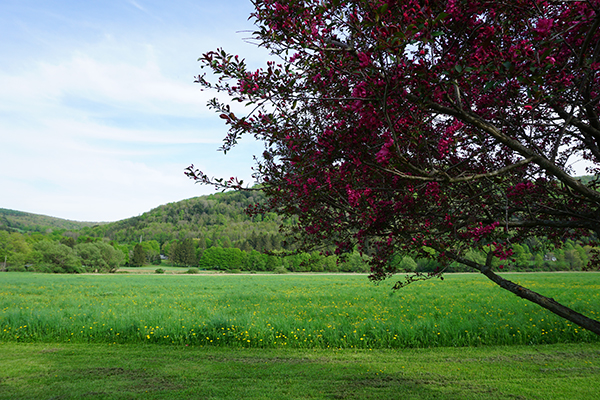It lurks along waterways, shading out native plants and starving the animals that eat them. Colonies haunt the roadsides. What is it? It’s the Tasseled Menace.
Japanese knotweed choked the streambank as I walked down by the Hamden covered bridge. It was a beautiful spring day with brilliant green leaves unfurling across the hills and grass waving in the light breeze. A day marred only by the presence of the invasive weed.
I’ve seen knotweed carpeting the banks of the West Branch of the Delaware River at several other places. I’ve even seen it between cement pieces in Walton parking lots. I began noticing it along the roadway between Hamden and Walton after the road crews sprayed herbicide. Their efforts were mocked by the multitude of vibrant stems living just beyond the two-foot-wide front row that had succumbed to the pesticide.
Japanese knotweed in Walton, NY growing back in late summer after a pesticide application in the spring
Japanese knotweed, aka the Tasseled Menace, is an escaped ornamental brought from Japan in the 1800s. Because it grows quickly, it has also been used as a land stabilizer, like kudzu, but its invasive characteristics led to a discontinuation of that practice by the 1930s. It is a handsome devil, as most invasive ornamentals are, with pretty white tassels of flowers in summer, hence the mocking moniker. This shrub-like plant can grow up to 15 feet tall. The stout, hollow, reddish-brown stems look similar to bamboo and the leaves are shaped like a spade or heart. It is tolerant to floods, drought, shade, salinity, and heat. It loves to colonize disturbed areas around streams, right-of-ways, roadsides, or any amount of soil that it can reach its dirty little rhizomes into that isn’t already occupied by another plant. Ideally a native plant, laughing in its face.
Spraying herbicide on just a portion of a Tasseled Menace grove only knocks it down, not out. It will return like unwanted fruitcake. As long as the rhizome, an underground stem, remains intact, it will live to menace another day. Multiple herbicide applications may be necessary to fully remove it, although some herbicides are inappropriate for use near waterways, such as the stretch of the West Branch of the Delaware, near the Hamden covered bridge, where I first saw those waving – deceptively heart-shaped – green leaves.
For the even greater satisfaction of seeing those stems fall immediately, small colonies can be grubbed out mechanically with a Pulaski and then bagged and disposed of in a secure location, such as a dumpster. MyWoodlot.com has some great resources for landowners who are interested in learning more about controlling invasive plants. For general information about Japanese knotweed, visit New York Invasive Species.
Japanese knotweed near the Hamden covered bridge 5/18/18
Spring near the Hamden covered bridge 5/18/18
Spring near the Hamden covered bridge 5/18/18









